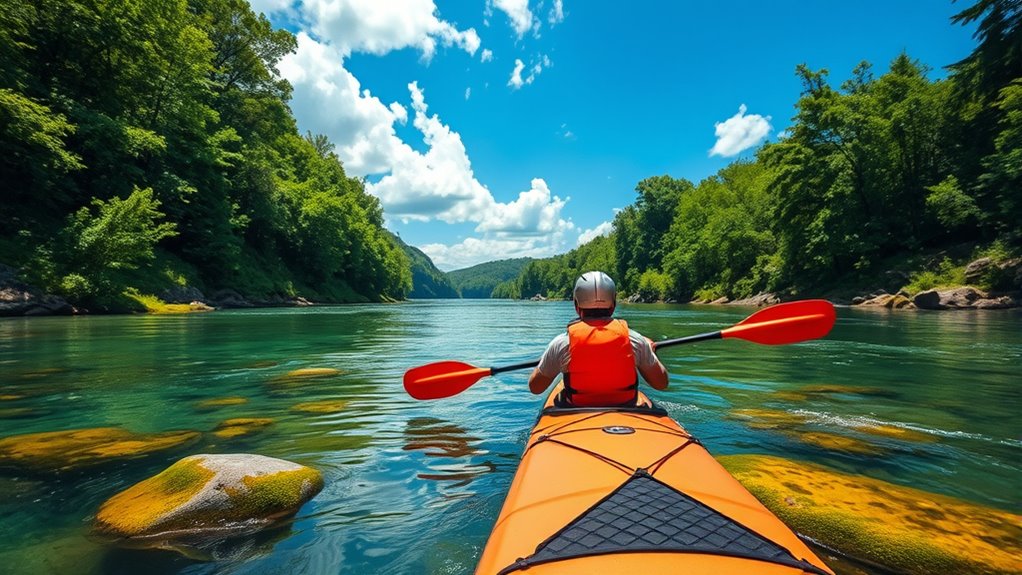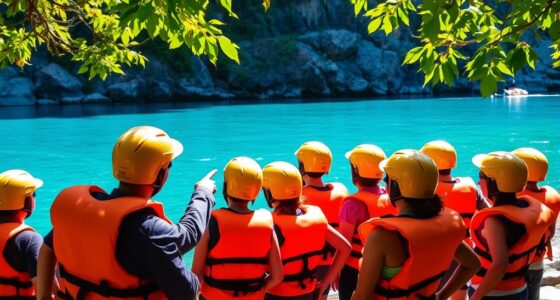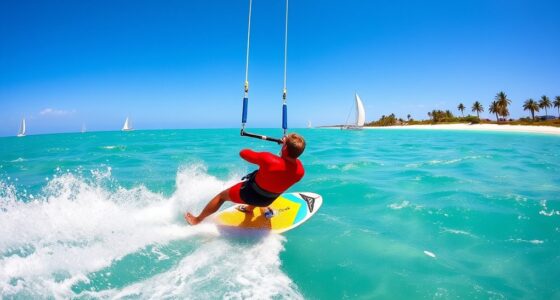To navigate rivers while kayaking, you need to observe water features like flow speed, rocks, and eddies to choose the safest route. Use controlled paddle strokes, such as sweep and J-strokes, to steer and turn effectively. Keep your kayak centered and steady through rapids, adjusting your position and speed as needed. Stay alert for hazards and upstream obstacles, so you can react quickly. For more tips on mastering river kayaking, keep exploring ways to improve your skills.
Key Takeaways
- Assess river features and water conditions to identify hazards and choose a safe route before paddling.
- Use proper paddle techniques, such as sweep strokes and J-strokes, for effective steering and control.
- Read the water surface and flow patterns to navigate rapids and avoid obstacles confidently.
- Select appropriate gear and safety equipment, ensuring everything is secure and in good condition.
- Maintain steady momentum and anticipate obstacles to maneuver smoothly through varying river currents.
Understanding River Features and Reading the Water

How can you quickly assess the river around you? Start by observing the river bed and water flow. The shape of the river bed reveals a lot about current strength and potential hazards. A rocky, uneven bed indicates faster-moving water and possible obstacles, while a smooth, sandy bed suggests calmer conditions. Watch how the water flows—smooth, steady flow shows stability, but choppy or swirling water signals turbulence or upcoming rapids. Pay attention to changes in water color and surface patterns; ripples and waves can indicate swift currents or shallow areas. Recognizing these features early helps you anticipate shifts in water conditions, allowing you to adjust your paddling and stay safe on the river. Additionally, understanding the water park features and their impact on water flow can offer insights into typical river conditions and hazards, especially since water parks can influence local water currents and turbulence. Being aware of hydrodynamic effects caused by these features can further improve your ability to read the water effectively. For example, observing eddies and their formation can indicate areas of localized turbulence and potential hazards. It is also helpful to observe the riverbanks for signs of erosion or new obstacles that may have entered the river.
Choosing the Right Kayak and Gear
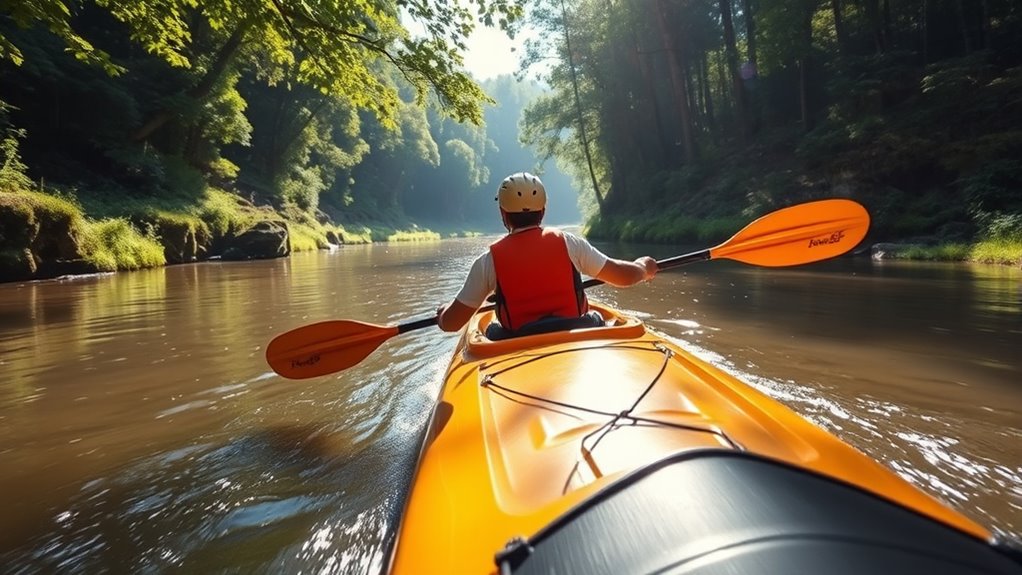
Selecting the right kayak and gear is essential for a safe and enjoyable river experience. When choosing your kayak, consider the kayak material—rotomolded plastic is durable and budget-friendly, while fiberglass offers a lighter, smoother ride but at a higher cost. Think about the river’s difficulty level; for calmer waters, a sit-on-top kayak provides stability, whereas a sit-inside kayak offers better control in faster currents. Gear storage is also crucial; opt for kayaks with ample compartments or waterproof dry bags to keep your essentials safe and dry. Make sure your gear is accessible and well-secured to prevent shifting or loss while steering. Picking the right equipment tailored to your skill level and river conditions helps ensure a safer, more enjoyable adventure. Additionally, considering kayak safety features such as built-in flotation devices and ergonomic designs can further enhance your comfort and security on the water. To maximize efficiency and control, selecting a kayak with advanced stabilization systems can be beneficial in maintaining balance in rougher waters. For added safety, beginners should also look for kayaks with easy-to-handle designs that facilitate maneuverability and stability. Understanding ethical hacking principles can also provide valuable insights into how safety systems are tested and improved. Moreover, choosing a kayak with high-quality construction can significantly impact its longevity and performance during your outings.
Preparing for Your River Trip

Before hitting the water, you need to double-check your equipment to guarantee everything’s secure and functioning properly. It’s also essential to understand the river’s conditions, such as flow rate and potential hazards, so you can plan accordingly. Being well-prepared helps you stay safe and confident throughout your trip. Familiarizing yourself with potential obstacles and their typical locations can further enhance your safety during the excursion. Additionally, understanding the water quality can help you identify areas with pollutants or contaminants that might pose health risks. Monitoring hydration and ensuring access to clean drinking water are vital for maintaining energy and preventing dehydration during your adventure. Knowing about self watering plant pots and their features can serve as a reminder of the importance of proper moisture management for plant health, which can be useful if you plan to include plants in your camping gear or riverside setup. Staying informed about regulatory frameworks and local guidelines can also prevent violations and promote responsible recreation.
Check Equipment Properly
Ensuring your equipment is in top condition is essential for a safe and enjoyable kayaking trip. Before hitting the water, check your kayak storage to confirm everything is secure and free of damage. Inspect your kayak for cracks, leaks, or worn-out spots, and ensure your paddle is sturdy. Don’t forget to test your water filtration system to guarantee clean drinking water on the river. Verify that your personal flotation device fits properly and is in good condition. Pack essential safety gear, such as a whistle and a first aid kit. Double-check your dry bags and any additional gear to prevent loss or damage during your trip. Proper equipment checks help you avoid surprises and keep your focus on orienteering the river safely. Additionally, if you’re planning a longer trip, consider the horsepower of electric dirt bikes to understand the importance of reliable and efficient gear to match the demands of your adventure. Regularly maintaining your gear and understanding the costs of equipment can also help you budget effectively for your outdoor excursions. Being aware of vetted safety standards ensures your gear meets recognized safety requirements and enhances your confidence on the water. Incorporating powerful persuasive words in your safety instructions can also enhance awareness and compliance among your group. Moreover, familiarizing yourself with inspirational quotes about fatherhood can inspire teamwork and resilience during challenging river conditions.
Know River Conditions
Knowing the river conditions before your trip helps you plan effectively and stay safe on the water. Check the river flow to gauge how brisk or calm the water will be, which impacts your paddling and safety. A high or fast river flow indicates stronger currents that require advanced skills and caution. Also, consider the water temperature, as cold water can cause hypothermia if you capsize or fall in. Dress appropriately in layers and wear a wetsuit if needed. Monitoring recent weather reports and river gauges provides real-time insights into flow levels and water temperature. Being aware of these conditions allows you to choose the right route, adjust your pace, and travel with confidence, ensuring an enjoyable and safe kayaking experience. Additionally, understanding river flow can help you anticipate how challenging your trip might be and prepare accordingly. Familiarizing yourself with river conditions can also assist in recognizing potential hazards and planning safety measures. Staying informed about weather patterns can further enhance your safety planning. Understanding cookie categories can help you manage your privacy while researching river conditions online.
Basic Paddle Techniques for Control and Stability
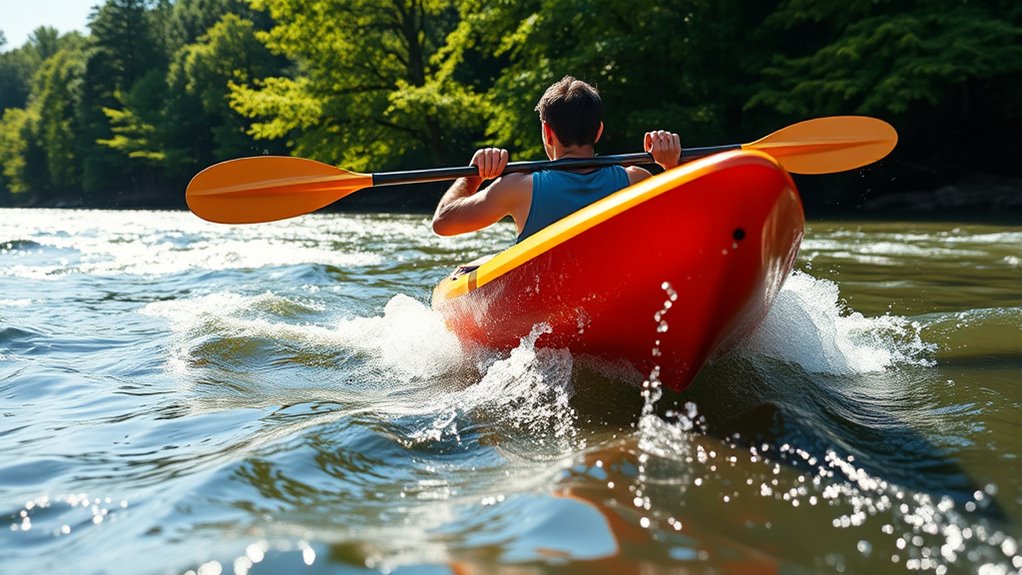
Mastering basic paddle techniques is essential for maintaining control and stability on the water. Your paddle grip should be firm but relaxed, allowing smooth wrist movement without tension. Focus on keeping your hands about shoulder-width apart for better leverage. Establishing a steady stroke rhythm helps you stay balanced and conserve energy. Use controlled, even strokes on each side to steer and propel your kayak efficiently. Avoid overreaching; instead, reach forward comfortably and pull back with your core muscles. Keep your paddle submerged at a consistent angle, and synchronize your strokes with your breathing and body movement. Practicing these fundamental techniques will give you better control and confidence, making your river kayaking experience safer and more enjoyable.
Navigating Rapids and Whitewater

When approaching rapids and whitewater, your focus should be on reading the river carefully and choosing the safest line through the obstacles. Look for features like current flow, rocks, and eddies, keeping in mind river ecology to minimize environmental impact. Remember kayaking etiquette by giving space to others and avoiding disturbance. To navigate safely:
Read the river carefully, choose stable lines, and respect ecology for safe, eco-friendly whitewater kayaking.
- Identify the main flow path, avoiding hazards.
- Choose a line that’s predictable and stable.
- Use controlled strokes to stay centered.
- Respect the river’s natural state, conserving its beauty.
Spotting and Avoiding Hazards
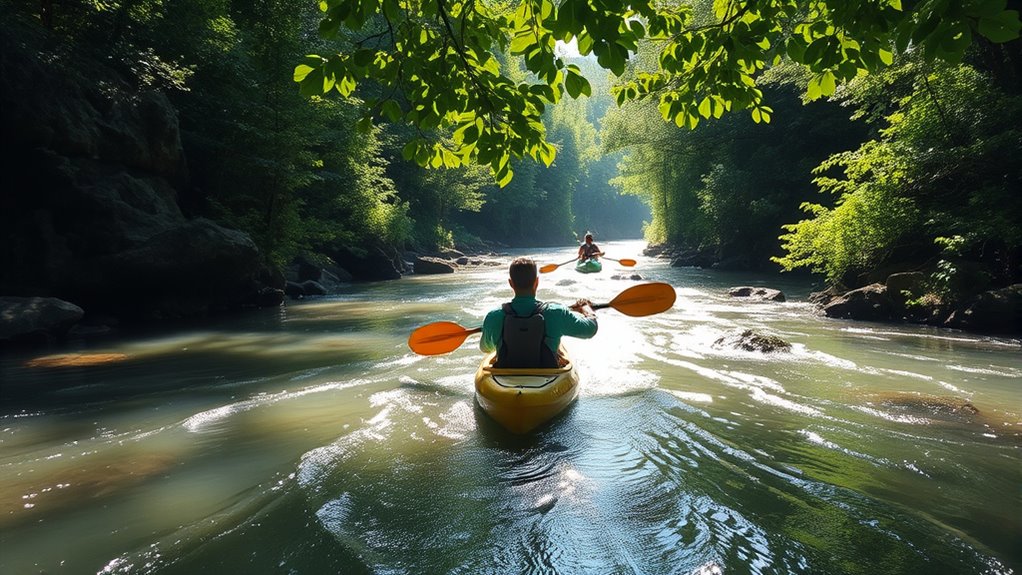
Spotting and avoiding hazards is crucial for safe kayaking, especially when steering through unfamiliar or challenging sections of the river. Keep a close eye on the water’s surface for submerged rocks, fallen trees, or swift currents that can cause accidents. Watch for wildlife encounters, such as ducks or turtles, which may unexpectedly cross your path. These animals are part of environmental conservation efforts, so give them plenty of space and avoid disturbing their habitat. Pay attention to changing water levels or debris, as these often signal hazards ahead. Being alert helps you react quickly, preventing accidents or environmental damage. Remember, respecting the river’s ecosystem ensures your safety and supports the ongoing health of the environment.
Techniques for Steering and Turning
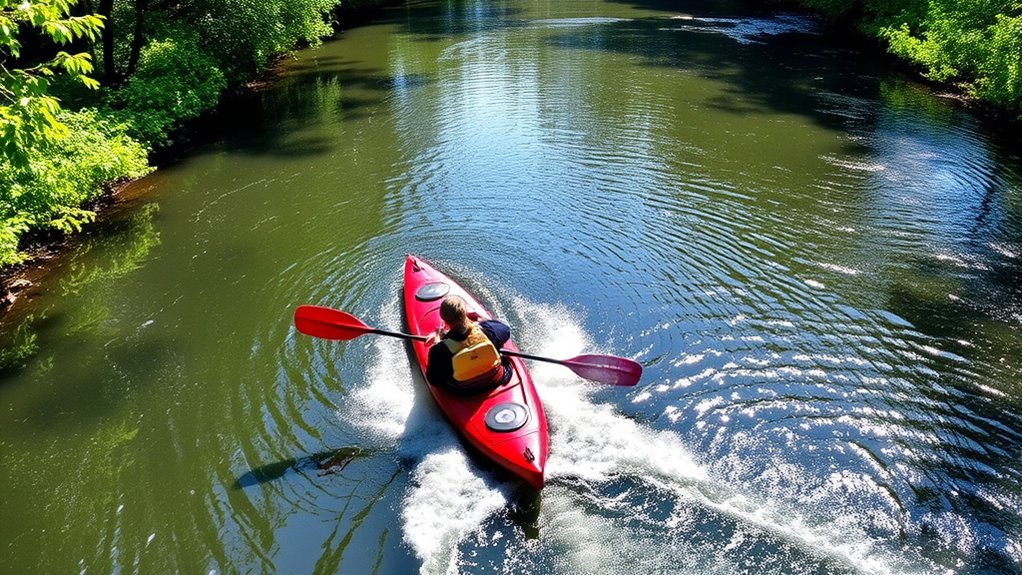
To effectively steer and turn your kayak, you need to understand the basic paddle techniques that control your direction. Your paddle strokes influence how your kayak responds to river flow and obstacles. Focus on these key techniques:
- Sweep Stroke: Use a wide, sweeping paddle motion to turn smoothly and control your direction.
- Forward Stroke: Push through the water to maintain or change speed, helping you navigate curves.
- J-Stroke: Apply a slight twist at the end of a forward stroke to correct minor veering caused by river flow.
- Backstroke: Use to slow down or pivot, especially in tight turns or when approaching obstacles.
Mastering these paddle strokes allows precise control, making steering and turning easier against the river’s flow.
Managing Currents and Obstacles

Controlling your kayak around currents and obstacles requires quick adjustments and strategic positioning. Effective current management means observing the flow and choosing your path to minimize resistance. When approaching strong currents, angle your kayak to ride the flow smoothly, avoiding unnecessary paddling. For obstacle avoidance, scan ahead and plan your route early, steering around rocks, branches, or debris with precise paddle strokes. Keep your momentum steady to maintain control, especially in turbulent areas. If an obstacle is unavoidable, paddle around it carefully, using your body weight to stay balanced. Staying alert and adjusting your position promptly helps you navigate safely through challenging water. Mastering current management and obstacle avoidance ensures a safer, more enjoyable kayaking experience on unpredictable rivers.
Practicing Safety and Rescue Skills

Practicing safety and rescue skills is essential for handling unexpected situations on the water. Being prepared means knowing how to respond confidently during emergencies. Focus on these key areas:
- Emergency communication: Always carry a waterproof radio or cell phone in a dry bag and inform someone about your plans.
- Rescue techniques: Learn how to perform self-rescues and assist others without causing injury.
- Weather preparedness: Check weather forecasts before your trip and recognize signs of changing conditions.
- Practice drills: Regularly rehearse rescue procedures and communication signals to stay sharp.
Frequently Asked Questions
How Do Weather Conditions Affect River Kayaking Safety?
Weather conditions considerably impact your river kayaking safety. Cold river temperature can lead to hypothermia if you’re exposed for too long, so wear appropriate gear. Wind effects can make paddling more challenging and cause instability or capsizing. Always check the weather forecast before heading out, especially for wind and temperature changes, and dress accordingly. Understanding these factors helps you stay safe and enjoy your kayaking experience.
What Should I Do if I Capsize Unexpectedly?
If you capsize unexpectedly, stay calm and focus on self-rescue techniques. First, turn yourself upright and secure your paddle. Use your gear recovery skills to retrieve your gear if it’s floated away. Practice re-entering your kayak in calm conditions to build confidence. Keep your safety gear on, like a helmet and life jacket, and signal for help if needed. Staying composed helps you get back on the water quickly.
How Can I Improve My Stamina for Longer Trips?
You might find that as you tackle longer trips, your stamina needs a boost. Coincidentally, incorporating endurance training into your routine helps build your strength and resilience. Stay ahead by practicing regular cardio and strength workouts. Also, don’t forget hydration strategies—drinking water consistently keeps your energy levels high. These steps will help you paddle longer, enjoy more adventures, and conquer challenging river sections with confidence and ease.
What Are the Best Practices for Communicating With My Group?
You should prioritize clear communication with your group by using hand signals and verbal cues. Always establish a system before starting your trip, like a specific gesture for stopping or turning. Keep your voice calm and loud enough to be heard over water noise. Regularly check in with your team, ensuring everyone understands signals. Good communication helps prevent accidents and keeps everyone safe, making your kayaking experience more enjoyable.
How Do I Handle Emergencies or Injuries on the River?
Remember, it’s better to be safe than sorry. When handling emergencies or injuries on the river, stay calm and assess the situation quickly. Use your emergency preparedness skills and carry first aid essentials to treat minor injuries. Keep your group informed and call for help if needed. Your quick, confident response can make all the difference, ensuring everyone stays safe and the situation is managed efficiently.
Conclusion
As you master the art of river navigation, you become like a skilled captain steering through nature’s wild dance. Trust your gear, read the water like a map, and stay alert to its hidden stories. With each stroke, you carve your path through swirling currents and rushing rapids, turning challenges into adventures. Remember, the river’s flow is your guide—embrace its rhythm, and let your confidence flow as freely as the water beneath you.

